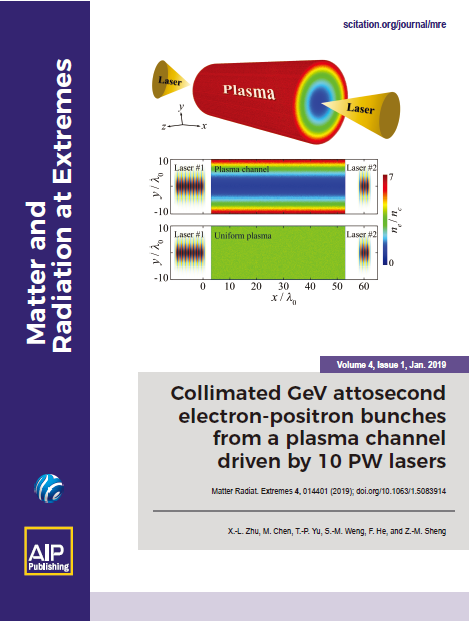Matter and Radiation at Extremes, 2019, 4 (1): 015401, Published Online: Mar. 20, 2019
Characterization of supersonic and subsonic gas targets for laser wakefield electron acceleration experiments
Figures & Tables
Fig. 1. Scheme of the supersonic de Laval nozzle (Smartshell Co., Ltd). This is a rapid-expansion nozzle optimized for helium and argon (γ = 1.66) and with a 140 µm inner throat and a 6.8 mm × 1.26 mm exit. The nozzle exit walls (those of length 1.26 mm) are removable, allowing a tunable longitudinal density profile.

Fig. 2. (a) Interferogram of the longer side of the nozzle. Two density peaks are clearly visible. These data are for argon gas with a backing pressure of 30 bar. (b) Comparison of the longitudinal density profiles predicted by simulations (dashed curves) with the values measured by interferometric tomography (solid curves). The density profiles are compared at two different heights above the nozzle: 0.15 mm and 1 mm. The input gas is the same for both cases: argon at 30 bar.

Fig. 3. Dependence of the transverse density profile of the supersonic de Laval rectangular nozzle on the gas type. The backing pressure used for all three gases is 30 bar. The profiles are simulated, and the data are extracted at a height of 0.5 mm above the nozzle.

Fig. 4. Graphical representation of the quantities appearing in Eqs. (1) and (2) . The green arrow shows the direction of the flow through the nozzle. The lines W 1 and W 2 represent the infinitesimal variations of the nozzle wall, and θ is the angle between them. The vectors V 1 and V 2 represent the velocities of the incoming and outgoing gas flows, respectively, and M 1 and M 2 are the corresponding Mach numbers. The line S represents the shock wave occurring at an angle β .

Fig. 5. Comparison of the three normalized density profiles obtained using the supersonic gas target. The density profiles were extracted 0.5 mm above the nozzle, and the simulated gas was nitrogen. In LWFA experiments, the laser propagates from right to left.

Fig. 6. Transverse density profiles with (solid curves) and without (dashed curves) the blade at different heights above the blade. The blade was placed 3 mm above the exhaust and 0.9 mm from the center of the nozzle. The simulation was performed with helium at 30 bar. Profiles are plotted at heights of 0.3 mm, 0.5 mm, and 1 mm above the blade, which correspond respectively to heights of 3.8 mm, 4 mm, and 4.5 mm above the nozzle exhaust.

Fig. 7. (a) Peak-to-plateau ratio of the density peak induced by the blade vs. distance of the blade from the center of the nozzle. (b) Distance from the density peak induced by the blade and the plateau (gradient length) vs. distance of the blade from the center of the nozzle. The blade was placed 3 mm above the nozzle.

Fig. 8. (a) Interferogram of the capillary. The outgoing gas is clearly visible. These data are for argon gas with a backing pressure of 50 bar. (b) Comparison of measured (solid curves) and simulated (dashed curves) normalized density profiles at different heights above the exhaust. The density gradient between the peak and the vacuum depends strongly on the height above the exhaust. Furthermore, the values predicted by the simulations show a better match with measurements in the region closest to the exhaust. The gas used was argon at 50 bar.

Fig. 9. Capillary density profiles with (solid curves) and without (dashed curves) the blade at different heights above the blade. The blade was placed 0.05 mm from the center of the capillary and 0.5 mm above the capillary exhaust. The blade was 0.5 mm thick. The gas used was argon at 30 bar. Profiles are plotted at heights of 0.05 mm, 0.1 mm, 0.3 mm, 0.5 mm, and 1 mm above the blade, which correspond respectively to heights of 1.05 mm, 1.1 mm, 1.3 mm, 1.5 mm, and 2 mm above the nozzle exhaust.

S. Lorenz, G. Grittani, E. Chacon-Golcher, C. M. Lazzarini, J. Limpouch, F. Nawaz, M. Nevrkla, L. Vilanova, T. Levato. Characterization of supersonic and subsonic gas targets for laser wakefield electron acceleration experiments[J]. Matter and Radiation at Extremes, 2019, 4(1): 015401.



